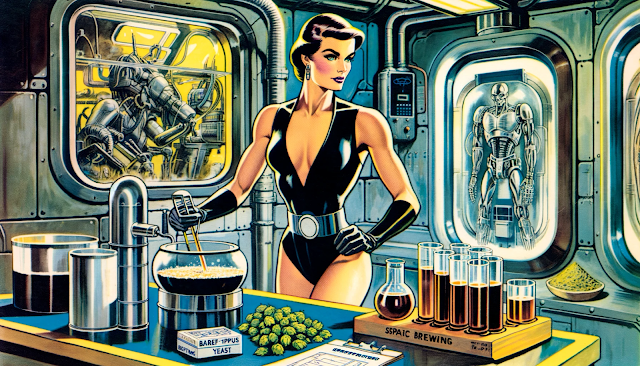The significant role of yeast in beer production became clear in more recent times, historically speaking. In 1836, a pivotal moment occurred when Baron Charles Cagniard de la Tour observed yeast cells through a microscope, recognizing their living nature. This observation fundamentally altered the brewing industry's course.
De la Tour's groundbreaking insights unveiled the true nature of fermentation, identifying it as a biological process fueled by the activity of yeast cells.
This groundbreaking discovery was part of a larger surge in scientific understanding during the 19th century. It was in this era that Louis Pasteur built upon de la Tour's findings, conclusively linking yeast to fermentation and explaining its manipulation and control.
Pasteur's work had a far-reaching impact, revolutionizing brewing from an art based on instinct and age-old techniques to a discipline grounded in scientific knowledge.
So, let's explore the subject of yeast and how it is a complex element of homebrew beer brewing.
Yeast: The Microbial Alchemist in Brewing
In the context of beer brewing, one particular family of yeast, Saccharomyces Cerevisiae, reigns supreme, and it's composed of two distinguished members: ale yeast and lager yeast. These yeast strains are the unsung architects behind the scenes, responsible for the alchemical process that turns malted barley, hops, water, and sometimes other adjuncts into the delightful brews enjoyed by enthusiasts across the galaxy.Ale yeast, known for its top-fermenting characteristics, is akin to a rebel spirit in the world of brewing. During fermentation, it exuberantly rises to the surface of the wort, the sugary liquid extracted from malted barley. This upward journey is a testament to its vivacious nature and robust fermentation process.
As it ferments at relatively warmer temperatures, typically between 60-75°F (15-24°C), ale yeast works swiftly, imparting a wide range of flavors and aromas to the beer. These flavors can span the spectrum, from fruity and estery notes to spicy and complex profiles, making ale yeast a versatile artist when it comes to crafting diverse beer styles.
On the other side of the yeast kingdom, we find lager yeast, the calm and collected counterpart to ale yeast's exuberance. Lager yeast is characterized by its bottom-fermenting behavior, gracefully settling at the bottom of the fermentation vessel. This disposition sets the stage for a slower and more controlled fermentation process, typically conducted at cooler temperatures, ranging from 45-55°F (7-13°C).
On the other side of the yeast kingdom, we find lager yeast, the calm and collected counterpart to ale yeast's exuberance. Lager yeast is characterized by its bottom-fermenting behavior, gracefully settling at the bottom of the fermentation vessel. This disposition sets the stage for a slower and more controlled fermentation process, typically conducted at cooler temperatures, ranging from 45-55°F (7-13°C).
The unhurried pace allows lager yeast to work methodically, producing a cleaner and crisper beer profile. Lager beers are often associated with a smooth, clean taste that allows the subtle nuances of the malt and hops to shine through, creating a refreshing and easy-drinking experience.
The differentiation between ale and lager yeast goes beyond their fermentation behavior and temperature preferences. It profoundly influences the overall character of the beer, dictating not only the flavor but also the aroma, mouthfeel, and appearance.
The differentiation between ale and lager yeast goes beyond their fermentation behavior and temperature preferences. It profoundly influences the overall character of the beer, dictating not only the flavor but also the aroma, mouthfeel, and appearance.
Yeast Behavior and the Art of Brewing
The fermentation process, a fundamental and magical alchemy set into motion by the introduction of yeast into the brewing process, is a complex biochemical dance where sugars are transformed into alcohol and carbon dioxide.This intricate and captivating transformation stands as the heart and soul of brewing, demanding meticulous attention to various factors such as temperature, pH levels, and the availability of essential nutrients.

In the intricate world of beer making, yeast emerges as an unsung hero, silently shaping the very essence of what we savor in our brews. From the robust and fruity notes of ales to the crisp and clean profiles of lagers, yeast's versatility is truly remarkable. Its sensitivity to temperature and the environment in which it operates allows brewers to craft an astonishing array of beer styles, each with its unique flavor and aroma. Yeast doesn't merely ferment; it transforms, adding layers of complexity and character that elevate beer from a simple beverage to a work of art. Moreover, yeast's role in fermentation extends beyond flavor.
Brewers find themselves in the role of both scientist and artist, as they strive to craft the perfect habitat for yeast, carefully balancing the biological requirements of these microscopic organisms with their own vision for the desired beer's flavor, aroma, and character.
In this delicate interplay between science and art, the brewer's ability to orchestrate these conditions becomes the key to unlocking the full potential of yeast and ultimately defining the unique personality of the beer being brought to life.
Distinctive Fermentation Traits of Ale and Lager Yeast
Ale yeasts, scientifically known as Saccharomyces cerevisiae, are known for their preference for moderate to warm fermentation temperatures. When these yeasts are used in the brewing process, they tend to produce esters, which are organic compounds responsible for imparting fruity and floral notes to the beer.These esters contribute to the complex aroma and flavor profiles found in ales. The specific esters produced can vary depending on factors such as yeast strain and fermentation conditions, allowing brewers to tailor the flavor profile of their ales. This versatility makes ale yeasts a popular choice among brewers looking to create a wide range of beer styles, from rich and malty to hop-forward and aromatic.
In contrast, lager yeasts, scientifically known as Saccharomyces pastorianus, have a preference for cooler fermentation temperatures. This results in a fermentation process that is characterized by a clean and crisp flavor profile, with a greater emphasis on the flavors derived from malt and hops, rather than yeast-derived esters.
In contrast, lager yeasts, scientifically known as Saccharomyces pastorianus, have a preference for cooler fermentation temperatures. This results in a fermentation process that is characterized by a clean and crisp flavor profile, with a greater emphasis on the flavors derived from malt and hops, rather than yeast-derived esters.
Lager yeasts are often used in the production of lagers, which are known for their clarity, mild yeast character, and refreshing qualities. The cooler fermentation temperatures of lagers also tend to result in longer fermentation periods, allowing for a smoother and cleaner fermentation process. Overall, the choice of yeast, whether ale or lager, and the fermentation temperature are pivotal factors in shaping the taste and aroma of the final beer product.
Yeast Pitching: The Critical Intersection of Timing and Temperature
Pitching yeast is a crucial step in the brewing process, and it plays a significant role in ensuring yeast health and fermentation efficiency. When brewers add yeast to the cooled wort, they initiate the fermentation process, where yeast consumes the sugars in the wort and produces alcohol and carbon dioxide.To achieve the best results, it's essential to maintain optimal temperatures for the specific type of yeast being used, whether it's ale yeast or lager yeast. Yeast strains have different temperature preferences, and deviating from these preferences can lead to unwanted flavors and aromas in the final beer.
Additionally, brewers need to adjust the volume of wort they add yeast to, which helps standardize the fermentation process across different batches of beer. This careful control of yeast pitching conditions is fundamental in achieving consistent and high-quality beer.
Monitoring temperature fluctuations during fermentation is another critical aspect of the brewing process. Yeast is sensitive to temperature variations, and significant swings can stress the yeast cells, leading to fermentation issues such as stuck or incomplete fermentation.
Monitoring temperature fluctuations during fermentation is another critical aspect of the brewing process. Yeast is sensitive to temperature variations, and significant swings can stress the yeast cells, leading to fermentation issues such as stuck or incomplete fermentation.
Brewers often use temperature-controlled fermentation chambers or tanks to maintain a stable environment for the yeast. This not only prevents stress but also allows for better control over the flavor profile of the final beer.

The Critical Role of Yeast Vitality in Beer Brewing
Yeast vitality, a cornerstone of successful fermentation, hinges upon the age and health of the yeast cells at the heart of the brewing process.Fresh yeast brings vigor and efficiency to the critical task of metabolizing sugars and converting them into alcohol and carbon dioxide. However, as yeast ages its vitality wanes, and this can potentially give rise to fermentation challenges that brewers must navigate.
When yeast is considered "tired" or aged, it may struggle to ferment the wort effectively. This can result in slower fermentation rates, incomplete attenuation, off-flavors, or even the dreaded "stuck fermentation" where yeast ceases its transformative work prematurely. These issues can be especially problematic for high-gravity beers, which contain higher concentrations of sugars and therefore demand more from the yeast.
Enter the yeast starter, a tool in the brewer's arsenal designed to breathe new life into yeast cultures. Like a rejuvenating elixir, yeast starters are essentially mini-batches of wort that provide yeast cells with a nurturing environment to regain their vitality before being introduced to the main batch of beer. Brewers often use yeast starters for high-gravity beers because these brews place a greater strain on yeast due to the elevated sugar content.
Yeast starters serve a dual purpose. First, they help identify any potential issues with yeast health and viability before they affect the entire batch. If yeast in the starter fails to become active and healthy, it's a clear signal that a fresh yeast culture should be used instead. Second, for yeast cultures that show promise but need a boost, the starter allows them to multiply and build up their strength. It's akin to a training camp for yeast, ensuring they are at their peak performance before the main event.
Using baking yeast for beer can result in unexpected flavors and lower alcohol content, and differences in flocculation properties can lead to cloudier beer.
When yeast is considered "tired" or aged, it may struggle to ferment the wort effectively. This can result in slower fermentation rates, incomplete attenuation, off-flavors, or even the dreaded "stuck fermentation" where yeast ceases its transformative work prematurely. These issues can be especially problematic for high-gravity beers, which contain higher concentrations of sugars and therefore demand more from the yeast.
Enter the yeast starter, a tool in the brewer's arsenal designed to breathe new life into yeast cultures. Like a rejuvenating elixir, yeast starters are essentially mini-batches of wort that provide yeast cells with a nurturing environment to regain their vitality before being introduced to the main batch of beer. Brewers often use yeast starters for high-gravity beers because these brews place a greater strain on yeast due to the elevated sugar content.
Yeast starters serve a dual purpose. First, they help identify any potential issues with yeast health and viability before they affect the entire batch. If yeast in the starter fails to become active and healthy, it's a clear signal that a fresh yeast culture should be used instead. Second, for yeast cultures that show promise but need a boost, the starter allows them to multiply and build up their strength. It's akin to a training camp for yeast, ensuring they are at their peak performance before the main event.
Baking Yeast Versus Brewing Yeast: A Functional Distinction
Though both baking and brewing yeast are Saccharomyces cerevisiae, they are specialized for their respective roles. Baking yeast, optimized for rapid CO2 production, has lower alcohol tolerance than brewing yeast, which is bred for beer flavor contribution and alcohol tolerance.Using baking yeast for beer can result in unexpected flavors and lower alcohol content, and differences in flocculation properties can lead to cloudier beer.
-
It is yeast that converts the sugars in wort into alcohol and carbon dioxide, a chemical dance that has been perfected over centuries of brewing tradition. Yeast's contribution to beer's texture, mouthfeel, and overall drinking experience cannot be overstated. It's the yeast that can turn a good beer into a great one, making it not just about the ingredients, but the mastery of the process. In essence, yeast is the invisible hand guiding the evolution of beer. Its influence is subtle yet profound, and it reminds us that beer is a living, breathing creation.
Cheers to you Mr Cagniard de la Tour!


